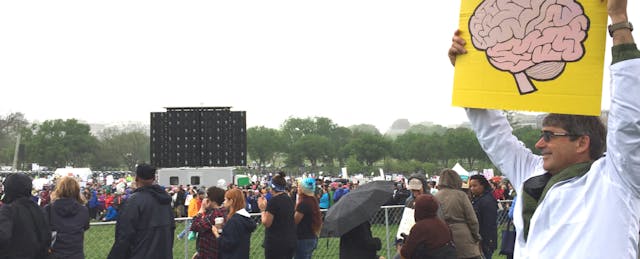Alfonso Arriola has been teaching middle school science in Portland, Oregon for almost 19 years, and unlike the Earth Days he has planned in the past, this year he was marching with his students at a rally.
“I talked to my students about why scientists are marching,” said Arriola. “I’m not only teaching the practice of science but about the social, moral and environmental impact of it.”
Signs he made with his seventh graders during a recess and lunch break read, “Science Not Silence” and “Science Provides Inspiration and Innovation.” He hopes to send a message to the world that the subject he teaches matters to society.
There are educators who disagree with teachers like Arriola, however, noting that the politicization of science can be detrimental to the entire field, as left and right groups begin to adopt facts based on their political affiliations.
But as Arriola sees it, science has always had a political element to it. “Science helps us inform questions that politicians make decisions on,” he explained. “For example, when we talk about climate change scientists come up with the evidence, then the politics come in.” He says that is why he teaches students about the history and development of science so that they can make their decisions about its place in society. “I respect whatever your political views might be,” the teacher added.
Arriola was not alone in his desire to participate in a protest on Saturday. Several teachers, education associations such as the National Science Teachers Association, and administrators around the nation were also present.
Marching on the other side of the country was Jeanette Valentino, a teacher from New Jersey who stood on the National Mall in Washington DC holding a sign that read: “Teach Real Science in Schools. Not Fake Science.”
As she stood among thousands of other science supporters, Valentino said that she did not view her message or the event as partisan—and organizers said the same. “We’re just concerned citizens for science,” she said, noting that her goal was to raise awareness of the importance of science education. (She added, though, that she saw plenty of anti-Trump and liberal sentiment on other signage.)
And for many protesting at the nation’s capital on Saturday, policy threats and political climate were the reasons they showed up. One speaker on the stage held up her pink knit hat from when she participated in the Women’s March in DC in January and said she was proud to continue her activism against the Trump Administration at the March for Science.
Charles P. Taylor, a neuroscientist from Ann Arbor, Michigan, wore his white lab coat to the march and held a sign that read “Mind… Your Brain.” He is mostly retired, but he worked for drug companies for decades and helped develop a pain medication. He said his hope was to advocate for more federal funding for science research.
“Medicines like the one I helped invent don’t happen in a vacuum. They start with basic research funded by large federal grants,” Taylor said. “I hope that people including our legislators are reminded that America is a technology leader and it would be shooting ourselves in the foot to cut science funding.”


